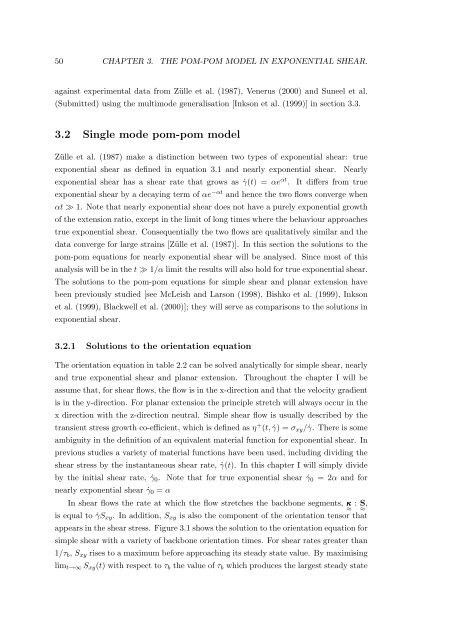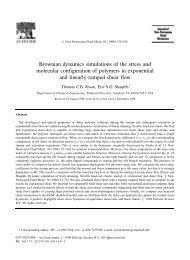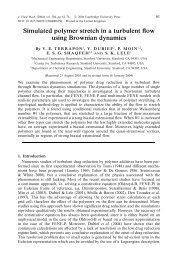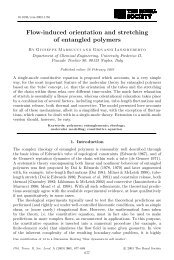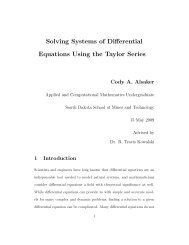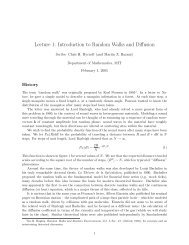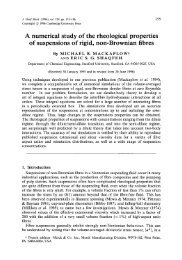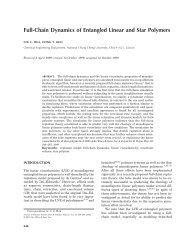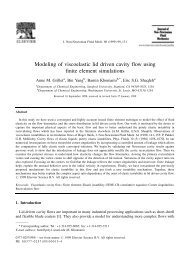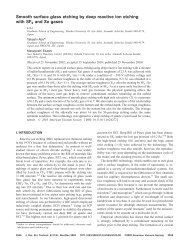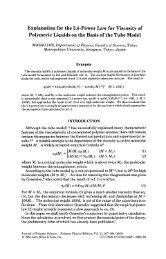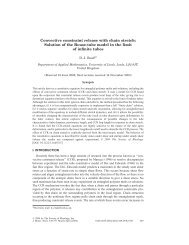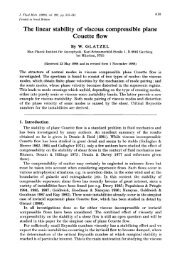Molecular modelling of entangled polymer fluids under flow The ...
Molecular modelling of entangled polymer fluids under flow The ...
Molecular modelling of entangled polymer fluids under flow The ...
You also want an ePaper? Increase the reach of your titles
YUMPU automatically turns print PDFs into web optimized ePapers that Google loves.
50 CHAPTER 3. THE POM-POM MODEL IN EXPONENTIAL SHEAR.<br />
against experimental data from Zülle et al. (1987), Venerus (2000) and Suneel et al.<br />
(Submitted) using the multimode generalisation [Inkson et al. (1999)] in section 3.3.<br />
3.2 Single mode pom-pom model<br />
Zülle et al. (1987) make a distinction between two types <strong>of</strong> exponential shear: true<br />
exponential shear as defined in equation 3.1 and nearly exponential shear. Nearly<br />
exponential shear has a shear rate that grows as ˙γ(t) = αe αt . It differs from true<br />
exponential shear by a decaying term <strong>of</strong> αe −αt and hence the two <strong>flow</strong>s converge when<br />
αt ≫ 1. Note that nearly exponential shear does not have a purely exponential growth<br />
<strong>of</strong> the extension ratio, except in the limit <strong>of</strong> long times where the behaviour approaches<br />
true exponential shear. Consequentially the two <strong>flow</strong>s are qualitatively similar and the<br />
data converge for large strains [Zülle et al. (1987)]. In this section the solutions to the<br />
pom-pom equations for nearly exponential shear will be analysed. Since most <strong>of</strong> this<br />
analysis will be in the t ≫ 1/α limit the results will also hold for true exponential shear.<br />
<strong>The</strong> solutions to the pom-pom equations for simple shear and planar extension have<br />
been previously studied [see McLeish and Larson (1998), Bishko et al. (1999), Inkson<br />
et al. (1999), Blackwell et al. (2000)]; they will serve as comparisons to the solutions in<br />
exponential shear.<br />
3.2.1 Solutions to the orientation equation<br />
<strong>The</strong> orientation equation in table 2.2 can be solved analytically for simple shear, nearly<br />
and true exponential shear and planar extension. Throughout the chapter I will be<br />
assume that, for shear <strong>flow</strong>s, the <strong>flow</strong> is in the x-direction and that the velocity gradient<br />
is in the y-direction. For planar extension the principle stretch will always occur in the<br />
x direction with the z-direction neutral. Simple shear <strong>flow</strong> is usually described by the<br />
transient stress growth co-efficient, which is defined as η + (t, ˙γ) = σ xy / ˙γ. <strong>The</strong>re is some<br />
ambiguity in the definition <strong>of</strong> an equivalent material function for exponential shear. In<br />
previous studies a variety <strong>of</strong> material functions have been used, including dividing the<br />
shear stress by the instantaneous shear rate, ˙γ(t). In this chapter I will simply divide<br />
by the initial shear rate, ˙γ 0 . Note that for true exponential shear ˙γ 0 = 2α and for<br />
nearly exponential shear ˙γ 0 = α<br />
In shear <strong>flow</strong>s the rate at which the <strong>flow</strong> stretches the backbone segments, κ : S,<br />
≈ ≈<br />
is equal to ˙γS xy . In addition, S xy is also the component <strong>of</strong> the orientation tensor that<br />
appears in the shear stress. Figure 3.1 shows the solution to the orientation equation for<br />
simple shear with a variety <strong>of</strong> backbone orientation times. For shear rates greater than<br />
1/τ b , S xy rises to a maximum before approaching its steady state value. By maximising<br />
lim t→∞ S xy (t) with respect to τ b the value <strong>of</strong> τ b which produces the largest steady state


